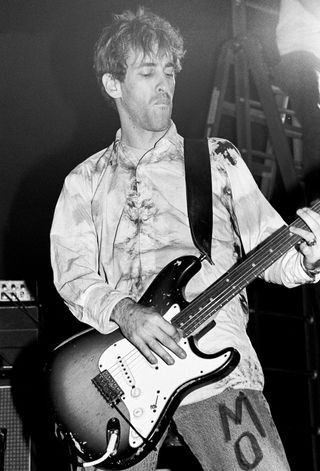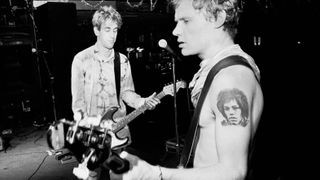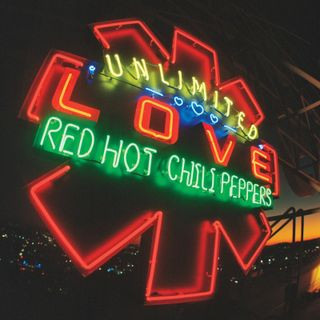60 years ago, the world welcomed Hillel Slovak (1962-1988), the Israeli-born guitar virtuoso who co-founded the Red Hot Chili Peppers. Though his life was tragically cut short at just 26, Slovak’s innovative guitar work remains foundational to the band’s signature sound and continues to inspire guitarists worldwide. Moving to the United States at the age of four, Slovak immersed himself in the vibrant Los Angeles music scene, setting the stage for his future impact.
In 1983, Slovak, alongside drummer Jack Irons, bassist Flea, and vocalist Anthony Kiedis, officially formed the Red Hot Chili Peppers. Slovak’s guitar was instrumental in forging the band’s distinctive funk-infused alternative rock sound. Even with the later addition of guitarists like John Frusciante, who propelled the band to global stardom, Slovak’s original vision remains the bedrock of their guitar identity. His pioneering techniques and unique approach to the electric guitar have influenced countless players, whether they consciously realize it or not.
 Hillel Slovak (1962 – 1988), of the group Red Hot Chili Peppers, plays guitar during a soundcheck before a sold-out performance at the Ritz, New York, New York, December 12, 1986
Hillel Slovak (1962 – 1988), of the group Red Hot Chili Peppers, plays guitar during a soundcheck before a sold-out performance at the Ritz, New York, New York, December 12, 1986
Hillel Slovak playing guitar with Red Hot Chili Peppers at The Ritz, 1986.
Interestingly, Frusciante wasn’t the only guitarist to temporarily leave and then rejoin the Red Hot Chili Peppers. In the early days, Slovak was juggling commitments with another L.A. band, the art-rock group What Is This, which featured the exceptional talents of Alain Johannes. Faced with increasing demands from both bands, Slovak had to make a choice. Ultimately, he initially opted to focus on What Is This, leading to Jack Sherman briefly taking over guitar duties for the Red Hot Chili Peppers. Sherman contributed to their self-titled 1984 debut album, recorded with Flea, Kiedis, and drummer Cliff Martinez.
However, Slovak’s departure was short-lived. He soon returned to the Chili Peppers, rejoining them for their sophomore album, 1985’s Freaky Styley. This album, produced by funk legend George Clinton, marked Slovak’s re-establishment as the band’s guitarist and further solidified their funk-rock fusion.
In a revealing 1984 interview with Johannes and Slovak, filmed shortly after the Red Hot Chili Peppers’ debut, Slovak discussed his difficult decision: “It got too hard to be in both bands at the same time,” he explained. “We were both being approached by [record] companies at exactly the same time. So you had to make a choice.”
With Slovak back in the fold, the Red Hot Chili Peppers steadily grew their fanbase throughout the mid-1980s. They entered the studio again to record their third album, 1987’s The Uplift Mofo Party Plan. This album, produced by Michael Beinhorn, is notable as the only Red Hot Chili Peppers studio album to feature all four founding members – Slovak, Irons, Flea, and Kiedis – throughout. It also marked Irons’ return to the band after his initial departure.
The following year, the band embarked on their first major European tour. This period was captured in the VPRO documentary Europe by Storm, offering a glimpse into the band’s early international experiences. A clip from this documentary showcases Slovak detailing his relatively simple but effective effects chain, a setup secured with duct tape directly onto the stage – a common practice before dedicated pedalboards became widespread.
Slovak’s pedal setup included essential tools for his signature sound: a Univox Super-Fuzz for thick distortion, a Cry Baby wah pedal for expressive tones, a Boss OD-1 Over Drive for boosting and adding grit, and a Boss CE-2 Chorus for adding depth and texture to his guitar.
The Red Hot Chili Peppers continued to expand their reach, returning to Europe in the spring of 1988, including a performance at the Pinkpop Festival in the Netherlands. Despite their growing success, the band was facing internal struggles. Anthony Kiedis, in his autobiography Scar Tissue, described this period as being “in the midst of a dark spirit,” recognizing that they were at a critical “do or die” juncture.
After playing what would tragically be their last concert together on June 2, 1988, in Oslo, Norway, the original lineup returned to Los Angeles. Weeks later, Hillel Slovak passed away at the young age of 26, a consequence of his battle with opiate addiction.
 Hillel Slovak (1962 – 1988) (left), on guitar, and American musician Flea (born Michael Balzary), on bass guitar, both of the Rock group Red Hot Chili Peppers, rehearse during a soundcheck before a sold-out performance at the Ritz, New York, New York, December 12, 1986
Hillel Slovak (1962 – 1988) (left), on guitar, and American musician Flea (born Michael Balzary), on bass guitar, both of the Rock group Red Hot Chili Peppers, rehearse during a soundcheck before a sold-out performance at the Ritz, New York, New York, December 12, 1986
Hillel Slovak and Flea rehearsing before a Red Hot Chili Peppers concert in 1986.
As the Red Hot Chili Peppers approach their 40th anniversary, marked by a star on the Hollywood Walk of Fame, their journey from the L.A. club scene to global icons is undeniable. This success story, however, is firmly rooted in the contributions of Hillel Slovak. His unique guitar playing and musical vision laid the foundation for everything that followed, a fact the band consistently acknowledges.
Anthony Kiedis poignantly stated in a recent interview with NME, “The energy of Hillel Slovak has never truly faded. Hillel’s still there in our hearts, whether it’s 30, 40, 50, 60 or even 100 [years].” Hillel Slovak’s legacy as a guitar innovator and a founding father of the Red Hot Chili Peppers endures, ensuring his music continues to resonate and inspire for generations to come.
 Red Hot Chili Peppers
Red Hot Chili Peppers
Red Hot Chili Peppers band photo.
Explore the Red Hot Chili Peppers catalog here or discover their latest album, Unlimited Love, here.
